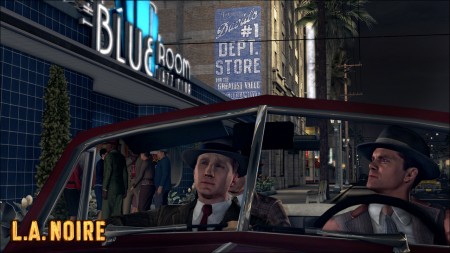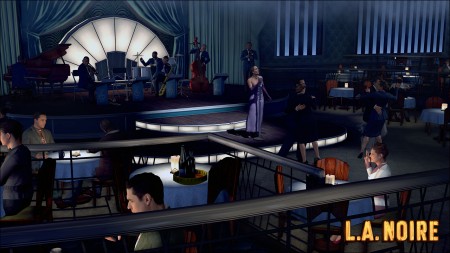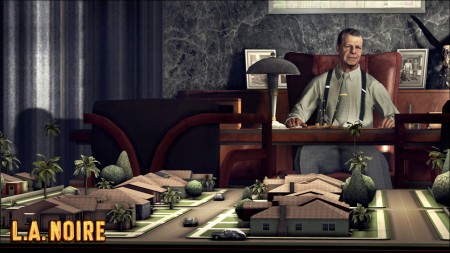L.A. Noire – The Verdict

There’s no denying that L.A. Noire is an adult game in the truest sense of the word. Yes, it has swears. Yes, it has blood. But L.A. Noire is probably the most mature of all the games featuring the Rockstar branding thus far. With themes of rape, exploitation, shady dealings and of course, murder it’s a game that proudly displays it’s genre on its sleeve. The only problem is, it doesn’t nearly reach the narrative heights it wants to, although it does provide a solid gaming experience.
Playing as Detective Cole Phelps, L.A. Noire tasks you with solving various crimes as you proceed through different departments of the Los Angeles police department; Traffic, Homicide, Vice and Arson. Each desk is home to several cases, which all must be tackled in a similar fashion – investigating crime scenes, interviewing suspects, some gunplay and of course, a fair amount of driving. The investigation components play a lot like a modern adventure game – you walk around, examining things that seem important (with sound and controller vibration hints if you desire) to the case. When you pick something up, you then may have the chance to investigate further, revealing important information and evidence vital to solving the case. These sections really add variety to the gameplay, slowing the pace down and giving you ample opportunity to think rather than gun your way to a solution.
One of the most touted features of Bondi’s creation is the MotionScan animation technology and it’s main purpose is to be utilised during the interrogation sections of the game. It’s quite something to not only be able to easily recognise many famous actors in the game, but more so their actual performances. Nervous people fidget, angry characters look furious and there’s a distinct veneer of polish that no virtual actor could realistically accomplish in a game like this. In terms of how it effects the game, the main use seems to mainly be to try and help clue you into tells and lies characters may try and throw at you – which can be a blessing and a curse, as sometimes it ends up looking a little forced – although understandable to ensure players aren’t stuck too much if they don’t know specifically what to look for. The flipside to this impressive technology is that it creates an almost uncanny valley like effect on the character models, looking like someone has surgically transplanted the actors face onto a mannequin.
The recreation of L.A. circa 1947 is absolutely stunning mind, and a rightly celebrated technical marvel. It really is quite something to be able to see famous Hollywood landmarks and the famous streets of LA that have been meticulously recreated to a degree. For game purposes, the city itself is split up into several neighbourhoods, and while some of these feel similar, a few such as the glitz and glamour of the Hollywood Hills area with mansions and theatres aplenty to the industrial and factory areas of the Warehouse districts feel contrasting from one another. On the negative side, there’s really not much going on in the city itself outside of the main plotline or the optional side missions. There’s no real sense that the NPCs are getting on with their lives or truly doing much more than being window dressing. It’s really apparent – and perhaps part of the aforementioned downside to having the recognisable actors, when you see the neighbour from Cougar Town as a drunk at one location, then working in an office and finally standing in line at the bank later.
Probably the major downfall with L.A. Noire is in the storytelling – especially towards the latter half of the game. For a game that has the genre it wants to be in the title, it wears it’s neo-noir stylings on it’s sleeve, and during the early parts of the game almost succeeds with things you’d probably expect such as gruff narration, characters with ulterior motives and a fair share of shady dealings. But aside from the shady dealings, these seem to fall by the wayside as the game progresses to rather more predictable conclusions. In addition the game is incredibly strict and linear to it’s narrative. Yes, there are cases which you can choose to arrest different suspects, or you can approach your investigations in the order you want to and be as thorough as you want to obtain a better rating at the end of each case- but it’s largely inconsequential. A wrong accusation sees your boss berating you, but the story dictates whether you get promoted or demoted, and the story will continue with very little or no consequences regardless.
It’s such a shame that L.A. Noire doesn’t live up to the lofty storyline heights it seems to promise, because there is still a good game in there. Although – and this is most noticeable with the Homicide desk – some of the cases can feel similar, it really does feel like the modern way to ‘do’ an adventure game, and it just about manages to get the balance right between shooting, driving and detective work right. And despite how negative the latter half of this review reads, Team Bondi certainly have the right foundations in place to make any further instalments in this series something absolutely brilliant. L.A. Noire is well worth a purchase, but for a game that has a clearly invested interest in it’s story, it’s a shame those storytelling aspects don’t quite reach the heights of its own ambitious desires & production values.
Verdict: On Target
Platforms available: Xbox 360, PS3
Version reviewed: XBox 360

